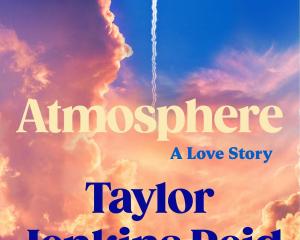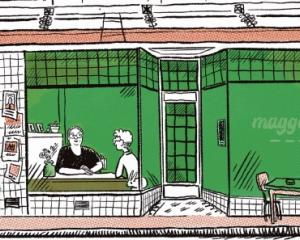You’ve read it at least three times, you refer back to it regularly to deal with all sorts of life issues, and you lend it to friends and demand, in a slightly alarming way, they read it — it is The Best Book in the World. Six Dunedin writers — three this week and three next — explain what is their Best Book in the World, and why.
 David Loughrey
David Loughrey
David Loughrey
David Loughrey

Listen. I’ll tell you something about the best book in the world.
The best book in the world is so good you can use it to refine your social life.
Take a copy of Irish author Flann O’Brien’s The Third Policeman: you can lend it to somebody you know, and based on their reaction to its contents, decide whether to accept them as a friend, downgrade them to an acquaintance, or, if they really don’t like it, drop them completely.
I have done this more than once, even with people I have known for some time.
The Third Policeman has the sort of qualities that any good friend should appreciate, and any rather tiresome or dull sort of comrade would not.
It is, from start to finish, funny.
Like the very best literature, it is also abundantly dark.
But it’s more than that.
It has the sort of astounding absurdity that only the finest minds — the sort of mind one might demand of a chum —could produce and appreciate.
There is the ongoing obsession with bicycles throughout the best book in the world, but not a normal obsession.
Bicycle clips, seats and lamps fascinate Flann O’Brien, but so does the matter of dissipated atoms from two-wheelers that result in the combining of bicycle and rider to the point their personalities mix and the country is beleaguered by half people and half bicycles.
Men who become more than half bicycle spend a lot of time leaning with one elbow against a wall or standing propped up by one foot on kerbstones.
There are the strange philosophies of de Selby — the footnotes on whom crowd out the text itself in parts — including his belief night-time is due to an accumulation of ‘‘black air’’ produced by certain volcanic activities.

There is no end to the zealously deranged inventiveness.
And the author and publication of The Third Policeman, both tinged with just the right amount of literary tragedy, only add to the exceptional level of gratification the book can provide the reader with the wherewithal to appreciate it.
O’Brien was one of the many pseudonyms of Brian O’Nolan, the fifth of 12 children, born in County Tyrone in 1911.
In 1935 he joined the Irish Civil Service ,and was private secretary to successive ministers for Local Government until he retired in 1953.
In 1940 he begana celebrated satirical column for the The Irish Times under the pseudonym Myles na Gopaleen, the pseudonym required because civil servants were not allowed to publish under their real names.
He was, it appears, an alcoholic.
Not only that, but there is a unique little tragedy associated with The Third Policeman: despite its glaringly obvious and untrammeled brilliance it was turned down by publishers.
O’Brien withdrew the manuscript, which he wrote in 1939-40, from circulation, and claimed he had lost it.
He died in 1966, and the book was published posthumously in 1967.
That failure adds the most gratifying, bitter poignancy to the whole experience.
What is The Third Policeman about?
It’s about a murder.
The narrator begins with a statement that makes that clear.
‘‘Not everybody knows how I killed old Phillip Mathers, smashing his jaw in with my spade.’’
The murder and its bizarre antecedents begin the story, and the narrative’s strangeness only ramps up after the deed is done.
The narrator finds himself in a rural Ireland where, for instance, skewed laws of physics and absurdities of perception means he can see the front and back of a building at the same time.
There is so much more, perversely strange, fiendishly weird and endlessly oddly dark, which at its best produces deep sighs as you take in your own lack of creative excellence in the face of such mastery of divine madness.
But you can read it yourself.
Then you can start to sort your world into people that share your fierce joy at Flann O’Brien’s brilliance, and those that don’t.
The latter group you can cast adrift, perhaps by email, or perhaps by sending them a strongly worded letter in a stamped envelope withdrawing your emotional support.
Because those people should be no longer your friends.
They just don’t get the sort of literary brilliance that any good friend should appreciate.
Best they be downgraded to acquaintances.
David Loughrey is an Otago Daily Times reporter and columnist, who writes short stories. He can bench press 50kg.

Emma Neale
The book that had the biggest impact on me is in two volumes, though even as I assert its influence, for a moment, I’m wavering.
Should I choose Roget’s Thesaurus instead?
As an undergrad I bookmarked entries for ambiguous and ambivalent, because the closer I looked at the world, the more meanings and possibilities seemed to proliferate.
Or should I select The Shorter Oxford English Dictionary, with ‘‘A-Markworthy’’ in gold on one blue spine, ‘‘Marl-Z and Addenda’’ on its partner?
The cover lettering shimmers like the wings of Thysanoplusia orichalcea: the slender burnished brass moth.
The blue is now as scuffed as a favourite pair of Levis.
The thin, apple-flesh white pages have speckled brown over the years, as if bruised with use. Ultimately, I think my choice has to be this battered set, because I can skive off the impossible task of nominating just one fiction or poetry title, and claim my choice contains all books.
As it transports the language of former British Empire, the SOED could legitimately be seen as a tool of oppression.
But for someone whose first language is English, the Shorter

My parents gave me a copy as a birthday gift, in my first year at university.
Its provenance adds sentimental value; even more than it would to, say, jewellery, because it expressed their commitment to education and their conviction that I could tackle what lay ahead. The two volumes have travelled with me overseas and back; merely looking at them on my study shelves can recentre me when everything else seems disarrayed.
The first volume always falls opens at page 723, headed up FALSEHOOD and FAMILY.
After my father died, I slipped in some photos of him there to keep them safe, and to ensure that I’d come across him regularly, even after he was gone.
It reminds me that my parents both backed my tertiary education right from the get-go; it reminds me that behind everything I write is the support I was lucky enough to have from my first word. (‘‘Brid,’’ apparently. Not brilliantly accurate, but maybe showed promise ...)
Set aside the photos of my father grinning as a baby in his cot, contented in my Gran’s arms as she stands in a front doorway apparently hollering for joy (heron-thin, she seems scarcely sturdy enough to hold up this long and robust wee pudding of a lad), in his lab-coat as a 40-something physician and immunologist, and the eye skips down the page to alight on falsetto, Falstaffian, famble-crop, famelic. I’m deliciously lost.
Entranced, curious, wandering off down side-alleys that open into other languages, cultures, epochs, specialisms, even personalities.
Imagine who might still use the word ‘‘spanker’’ to mean either a gold coin; anything exceptionally large or fine; or a person who takes long rapid strides.
Could I slip a character like that into a novel?
They’re wearing naval uniform, they’re striding along the main street in the port where they’ve just disembarked, chafing their hands in the cold, singing in bursts that frosts the air white as the head on a pint of Guinness. The thought of the first tangy, fizzing mouthful makes them lope faster along the docks, towards an inn ...
The dictionary contains a Scheherazade’s supply of small potted stories, or greatly compressed songs.
The rhythms and internal chimes of some definitions themselves seem shrewdly attentive to how a sentence flows, and how it might sound read aloud: fossicking through an entry it’s possible to unlock the sense of the thing itself, but also find micro-poems, mini fictions.
Sometimes, the alternative meanings are almost total opposites: there’s comedy in finding them cheek by-jowl, like seeing a punk with a 30cm high, fuschia-pink Mohawk next to a shiny-pated bald man on a train.
Hundreds of definitions in my edition speak of the bloody contrails of colonisation and the confining prejudice of sexism; because language itself is both vessel and weapon.
They also record so much that is lost: words whose etymology has been forgotten — orphans who leave us just with an echo of other centuries and life-ways.
The word ‘‘pingle’’, say: ‘‘Obs. Exc. dial, 1523 [of unknown origin] A small enclosed piece of land; a paddock; a close.’’
Such elements remind me that this is not the dictionary to end all dictionaries.
In real life, not playful exercises in singling out favourites, I also need multiple sources for te reo, Spanish, Swedish, Samoan, French . .. But the SOED taught me to love the random walk aspect of the printed version: the chance element of coming across new concepts, terms, strange marvels, when hunting for something else altogether.
It still bustles with a bewitching, imagination-bolstering carnival of flora, fauna, flaneurs, flames, flattery, fripperies, falsehood, family. . .
Emma Neale is a Dunedin novelist, poet, and a former Burns Fellow at the University of Otago. She is the editor of
Landfall, New Zealand’s longest-running arts and literary journal.

Kathryn van Beek
‘‘Where’s Papa going with that axe?’’
It’s one of the best lines in literature, and it opens the best book in the world — E. B. White’s 1952 children’s classic, Charlotte’s Web
The story is a coming-of-age tale about a pig.
The runt of the litter, Wilbur is saved by schoolgirl Fern Arable — but later discovers that he’s being fattened up for a fate that is death.
When an unlikely alliance between an anarchic arachnid and a revolting rodent results in the words ‘‘some pig’’ being woven into a web above his sty, the adults on the farm finally see what Fern has known all along — that Wilbur is worth saving.
It’s a wonderful book, but what makes it the best in the world?
To answer this question, we must first turn to another book — the dictionary.
The definition of the word ‘‘best’’, according to the Merriam-Webster, is ‘‘excelling all others’’. Charlotte’s Web excels all other books across the four key measures that make books best: best-selling, excellent, satisfying, and transcendent.

Some books for adults have outsold it, but the best book in the world requires the best audience in the world, and grown-ups have not earned that distinction.
That children are better than adults is demonstrated within the very pages of Charlotte’s Web.
At the beginning of the story, young Fern spares Wilbur from execution.
But by the end of the book, the more grown-up Fern is no longer righting the wrongs of the world, preferring instead to ride the Ferris wheel with a young man called Henry Fussy. (And we all know what that will lead to — the acquisition of a dreadful surname, and a lifetime spent cooking pork chops.)
As for excellence, Charlotte’s Web has won several literary honours, and it tops the School Library Journal’s list of best children’s novels.
The excellence of its Pulitzer Prizewinning author can be in no doubt; White co-authored the writer’s handbook, The Elements of Style.
That is to say, he wrote the book on how to write books.
White went to great lengths to observe the minutiae of nature — even transporting a spider’s egg sac from his farm to his office and allowing it to hatch on his desk.
His evocative use of detail makes reading Charlotte’s Web a truly satisfying experience. The book describes rural life in all its gritty realism, balancing bucolic buttermilk baths with wormy raspberries and rotten eggs.
Charlotte’s Web satisfies because it is both humorous and educational.
Under Charlotte’s tutelage we learn the meanings of words such as sedentary and gullible, which are just as relevant today as they were back in 1952.
The book’s humour could be described as dry, with hints of scat.
When the nesting goose can’t sleep, she complains, ‘I have nothing at all on my mind, but I’vetoo many things under my behind.’
Of course, books are most satisfying when they include pictures, and Garth Williams’ illustrations are iconic.
As a young reader I envied Fern as she tenderly bottle-fed her porcine baby, and was repulsed by Templeton the rat’s candy-swollen stomach.
As a grown-up I am charmed by Mrs. Arable nervously clutching her handbag as she seeks advice about Fern from her doctor.
And the illustrations of Wilbur doing a flip, attempting to spin a web, and smiling beatifically beneath the word ‘‘terrific’’ are simply magical.
Finally, we come to transcendence — the ways in which Charlotte’s Web makes a lasting impact.
It certainly caused a stir in 2006, when it was banned from a Kansas school because talking animals were considered blasphemous.
But what most people take from the book is an appreciation of friendship.
Some responsibility for vegetarian conversions, my own included, must also be laid at Wilbur’s hooves. (Despite empathising deeply with animals, White himself continued to farm pigs. His own granddaughter was moved to recreate the ‘‘some pig’’ web in a bid to save the life of one of them.)
Re-reading Charlotte’s Web, I’m struck by the ways in which my life has mirrored Fern’s. I too reared the runt of alitter (mine was feline).
My pet also attracted media attention, and the scenes in which crowds gather to watch Wilbur recall a time when my Bruce was blue-eyed, palm-sized and much-admired, and I feared he’d be cat-napped by one of his 43,000 Facebook fans.
But perhaps what is truly transcendent about Charlotte’s Web is its emphasis on the power of words and the value of writing.
One tiny spider has demonstrated to generations of children that every voice can make an impact.
Of course, White said it best:
‘‘It’s not often that someone comes along who is a true friend and a good writer. Charlotte was both.’’
Kathryn van Beek is an award-winning short story writer and the author of children’s book Bruce Finds A Home. She is engaged in doctoral study at Otago Polytechnic, on the topic ‘‘writing to change the world’’.











